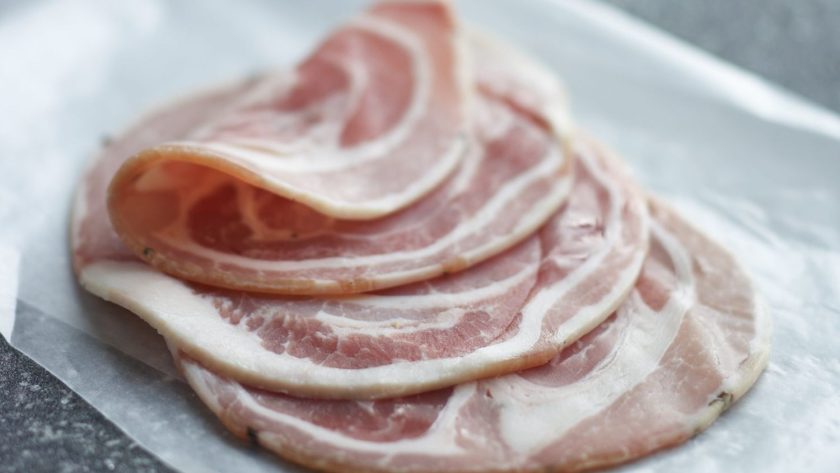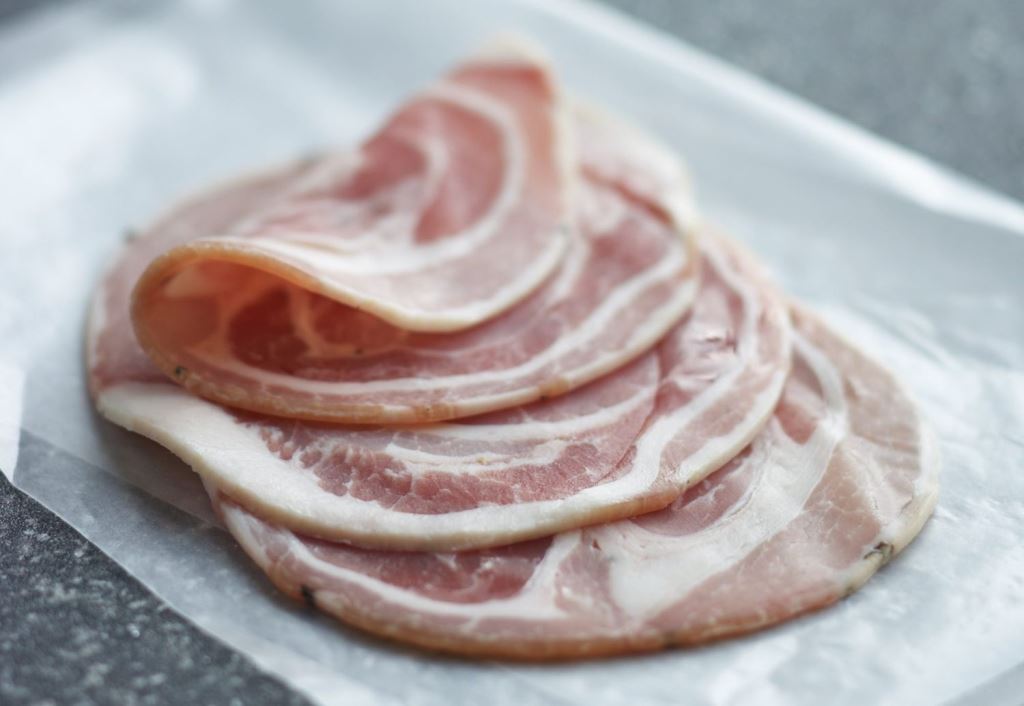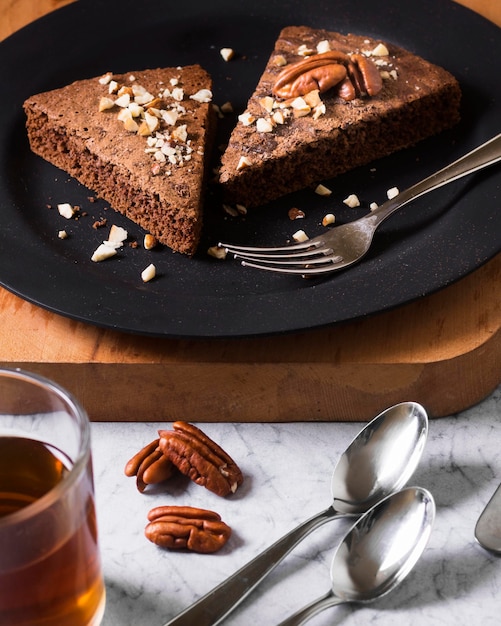Everything you need to know about what is pancetta – a flavorful Italian cured meat
When it comes to Italian cuisine, one delicacy that has gained international acclaim is pancetta. This savory, Italian-style bacon is known for its rich flavor and versatility in the kitchen. Whether you are a seasoned chef or an adventurous home cook, pancetta is a must-try ingredient that can elevate your dishes to new heights.
Unlike its American counterpart, pancetta is not smoked, allowing its pure pork flavor to shine through. It is made by curing pork belly with a combination of salt and spices, such as black pepper, garlic, and nutmeg. The curing process can take several weeks, during which the flavors intensify and the meat becomes tender and succulent.
Pancetta can be enjoyed in various ways, making it a staple in Italian cuisine. It can be thinly sliced and enjoyed on its own as an appetizer, where its savory and slightly salty taste instantly satisfies your palate. Additionally, pancetta can be used as a flavor booster in a wide range of dishes, from pastas and risottos to soups and stews.
One classic recipe that showcases the irresistible flavors of pancetta is the famous pasta dish, spaghetti alla carbonara. In this dish, pancetta is sautéed until crispy and then combined with beaten eggs, grated Parmesan cheese, and black pepper to create a creamy and indulgent sauce. The result is a mouthwatering combination of flavors, with pancetta adding a depth of smokiness and umami.
Whether you are looking to add complexity to your favorite dishes or simply indulge in the authentic flavors of Italy, pancetta is a culinary gem that should not be overlooked. Its versatility in the kitchen, combined with its rich and savory taste, make it a must-have ingredient for any food lover. So why not embark on a culinary adventure and discover the delicious wonders of pancetta for yourself?
What is Pancetta?
Pancetta is a type of Italian bacon that is made from pork belly. It is cured with salt and spices, and then dried for several months to develop its distinct flavor. It is most commonly used as a seasoning or flavoring agent in a wide range of Italian dishes.
Pancetta has a rich, savory taste that is often described as more intense and complex than traditional bacon. It is characterized by its delicate marbling and a slightly sweet and nutty flavor. The curing process helps to enhance the natural flavors of the pork, creating a product that is highly versatile and delicious.
There are two main types of pancetta: arrotolata (rolled pancetta) and stesa (flat pancetta). Arrotolata pancetta is rolled into a tight cylindrical shape, while stesa pancetta is laid flat. Both types can be used interchangeably in recipes, although the texture and appearance may vary slightly.
Pancetta in Italian Cuisine
Pancetta is a staple ingredient in many Italian dishes, adding a depth of flavor and richness to a variety of recipes. It is frequently used in pasta dishes like carbonara, amatriciana, and cacio e pepe, where it is typically diced or thinly sliced and sautéed before being incorporated into the sauce.
In addition to pasta, pancetta is also commonly used in soups, stews, and risottos. Its intense flavor pairs well with ingredients like beans, mushrooms, and vegetables, adding a luxurious touch to these dishes.
How to Use Pancetta
When using pancetta in cooking, it is important to note that its flavor is quite intense, so a little goes a long way. It is typically cooked before being added to recipes, as this helps to render the fat and develop its flavor.
To use pancetta in a recipe, start by cutting it into small pieces or thinly slicing it. Heat a pan over medium heat and add the pancetta, cooking it until it becomes crispy and the fat has rendered. Remove the pancetta from the pan, using a slotted spoon to drain off any excess fat, and then use it as desired in your recipe.
Pancetta can also be enjoyed on its own as a charcuterie or antipasto item. Serve it thinly sliced alongside cheeses, olives, and crusty bread for a delicious appetizer or snack.
Whether you’re using it to amp up the flavor of your favorite pasta dish or enjoying it on its own, pancetta is a versatile and delicious ingredient that adds a savory, umami taste to any culinary creation.
The Origins and Definition
Pancetta is an Italian cured meat that is made from pork belly. It is often referred to as Italian bacon and is commonly used in Italian cuisine. The word “pancetta” is derived from the Italian word “pancia,” which means belly. The culinary history of pancetta dates back to ancient Roman times, where it was commonly used in cooking and preserved for long periods of time.
Pancetta is typically made by soaking the pork belly in a mixture of salt, herbs, and spices, and then air drying it. The curing process can take anywhere from a few weeks to several months, depending on the desired flavor and texture. Pancetta can be found in different varieties, including smoked and unsmoked, and is often used as a flavoring ingredient in many dishes.
Regional Variations
There are several regional variations of pancetta within Italy, each with its own unique characteristics and flavor profiles. Some of the most famous types include:
| Region | Description |
|---|---|
| Pancetta Piacentina | Hailing from the Piacenza region of Emilia-Romagna, this variety is known for its delicate flavor and mild seasoning. |
| Pancetta di Calabria | From the southern region of Calabria, this variety is spiced with hot chili peppers, giving it a spicy kick. |
| Pancetta Tesa | This variety is rolled and tightly packed, resulting in a denser texture and a more intense flavor. |
Culinary Uses
Pancetta is a versatile ingredient that can be used in a variety of dishes. It is commonly used in pasta sauces, such as carbonara and amatriciana, where it adds a rich, savory flavor. It can also be used in salads, sandwiches, and as a topping for pizzas. Additionally, pancetta can be crisped up and served as a garnish or used to wrap around other ingredients for added flavor.
Overall, pancetta is a delicious and flavorful ingredient that adds depth and complexity to any dish it is used in. Its rich and savory taste is loved by many and it continues to be a popular choice in Italian cuisine.
Pancetta vs. Bacon
When it comes to cured pork, two popular options are pancetta and bacon. While they may seem similar, there are key differences that set them apart.
Pancetta is an Italian-style cured meat that is made from pork belly. It’s typically salted and seasoned with a combination of herbs, spices, and sometimes garlic. Pancetta is then rolled into a tight log and dry-cured for several months. The result is a rich and flavorful meat that is often sliced thin and used to enhance the taste of various dishes.
On the other hand, bacon is a popular breakfast food that is made from pork belly or back cuts. It is usually cured and smoked, giving it a distinct smoky flavor. Bacon is typically sliced into strips and cooked until crispy. It is known for its savory taste and crisp texture, making it a favorite in sandwiches, burgers, and as a flavorful addition to dishes.
One of the main differences between pancetta and bacon is the level of saltiness. Pancetta is typically less salty than bacon, allowing the other flavors to shine through. This makes it a versatile ingredient that can be used in a variety of dishes without overwhelming the palate.
Another difference is the cooking method. Pancetta is often used as a base ingredient in recipes, where it is cooked slowly to render out its fat and release its flavor. It can be diced and added to sauces, soups, and stews to add depth and richness. Bacon, on the other hand, is usually cooked until crispy, adding a salty and smoky crunch to dishes.
Both pancetta and bacon have their own unique flavor profiles and culinary uses. So whether you prefer the rich and savory notes of pancetta or the crisp and smoky taste of bacon, there are plenty of delicious dishes to explore with these versatile cured meats.
Differences in Flavor and Usage
Pancetta and bacon are both delicious cured pork products, but they have some distinct differences in flavor and usage.
Flavor
Pancetta has a rich, savory flavor that is often described as more complex and nuanced than bacon. It has a slightly sweet taste and is less smoky compared to bacon. The fat in pancetta is also firmer and melts slower when cooked, resulting in a different texture and mouthfeel.
Bacon, on the other hand, has a stronger, smoky flavor that is often associated with comfort food. It has a salty and savory taste with a hint of sweetness. The fat in bacon renders more quickly when cooked, creating a crispy and crunchy texture.
Usage
Pancetta is a staple in Italian cuisine and is used in a variety of dishes. It is commonly used to add flavor to pastas, sauces, soups, and stews. Pancetta can be sliced thin and fried until crispy to be used as a topping or ingredient in salads, sandwiches, and wraps.
Bacon, on the other hand, is a versatile ingredient that can be used in a wide range of dishes. It is often enjoyed as a breakfast meat and is used in sandwiches, salads, and burgers. Bacon is also commonly used to add flavor to casseroles, quiches, and other savory dishes.
Both pancetta and bacon can elevate the flavor of any dish they are used in, but their unique flavors and textures make them suitable for different culinary applications. Whether you’re looking for a more nuanced flavor for your Italian-inspired recipe or a smoky, comforting addition to your dish, choosing between pancetta and bacon will depend on your personal preferences and the specific requirements of your recipe.
Cooking with Pancetta
Pancetta is a versatile ingredient that adds incredible flavor to a variety of dishes. Whether you want to enhance the taste of soups, pastas, or main courses, pancetta is an excellent choice. Here are a few culinary uses to inspire your cooking:
1. Pasta Carbonara
One of the most popular ways to use pancetta is in the classic Italian dish, Pasta Carbonara. The salty and rich flavor of pancetta pairs perfectly with the creamy egg and cheese sauce. Simply dice the pancetta and cook it until crispy, then mix it with the cooked pasta and sauce for a delicious and satisfying meal.
2. Salad Dressings
Pancetta can also be incorporated into homemade salad dressings to add a savory twist. Render the pancetta until crispy, then crumble it and mix it with olive oil, vinegar, and your favorite herbs and spices. Drizzle this flavorful dressing over your salads for an extra boost of taste and texture.
3. Pizza Toppings
For pizza lovers, pancetta can be used as a delicious topping. Its smoky and slightly sweet flavor complements a variety of pizza ingredients. Simply cook the pancetta until crispy, then sprinkle it over your pizza before baking. You’ll be left with a savory and satisfying pizza that’s bursting with flavor.
4. Wrapped and Grilled
Another way to utilize pancetta is by wrapping it around other ingredients and grilling them. This technique adds a rich and smoky flavor to the dish. Wrap pancetta around asparagus spears, chicken breasts, or even scallops, then grill until the pancetta is crispy and the other ingredients are cooked through. The result is a mouthwatering dish with a perfect balance of flavors and textures.
5. Soups and Stews
Lastly, pancetta can be a delicious addition to soups and stews, adding depth and complexity to the overall flavor. Simply dice the pancetta and cook it until crispy, then add it to your favorite soup or stew recipe. The pancetta will infuse each bite with its smoky and savory taste, taking your soup or stew to the next level.
With its rich and savory flavor, pancetta is a fantastic ingredient to have in your kitchen. Use it in these ways, or get creative and experiment with your own ideas. No matter how you choose to cook with pancetta, you’re guaranteed to elevate the taste of your dishes and delight your taste buds.
Ways to Incorporate it into your Dishes
If you find yourself with a delicious slab of pancetta in your kitchen, here are some great ideas on how to incorporate it into your dishes:
1. Pasta Carbonara: Pancetta is an essential ingredient in this classic Italian pasta dish. Sautee diced pancetta until crispy, then mix it with cooked pasta, eggs, Parmesan cheese, and a little black pepper for a creamy and savory dish.
2. Paninis and Sandwiches: Slice pancetta thinly and use it in place of bacon in your favorite sandwiches and paninis. It adds a rich, salty flavor that pairs well with a variety of ingredients.
3. Pizza Topping: Crumbled pancetta makes for a delicious pizza topping. Add it to your favorite pizza along with other toppings like mushrooms, onions, and cheese for a gourmet twist.
4. Roast Potatoes: Wrap small pieces of pancetta around bite-sized potatoes and roast them in the oven for a savory side dish. The pancetta will add a crispy, salty crust to the potatoes.
5. Soups and Stews: Pancetta can add depth and richness to soups and stews. Sautee diced pancetta with onions and garlic as a base for your soup, or add it to slow-cooked stews for extra flavor.
6. Bruschetta and Crostini: Top slices of toasted baguette with a mixture of diced tomatoes, pancetta, and fresh herbs for a delicious appetizer.
7. Pasta Sauces: Pancetta can be used in various pasta sauces to add a meaty and smoky flavor. Sautee it with onions and garlic before adding tomatoes and other ingredients for a flavorful sauce.
These are just a few examples of how you can incorporate the delicious flavors of pancetta into your dishes. Don’t be afraid to experiment and discover new ways to enjoy this versatile ingredient!
Traditional Italian Pancetta Recipes
Pancetta is a delicious cured pork belly that is a staple in Italian cuisine. It is often used as a flavoring ingredient in many Italian dishes, adding a rich and savory taste to the final product. Here are a few traditional Italian recipes that make great use of pancetta:
Pasta Carbonara
This classic Italian dish is made with pancetta, eggs, cheese, and black pepper. The pancetta is cooked until crispy and then tossed with spaghetti and a mixture of beaten eggs, grated cheese, and black pepper. The heat from the pasta cooks the eggs, creating a creamy and flavorful sauce. This quick and easy dish is perfect for a weeknight dinner.
Pasta all’Amatriciana
This pasta dish originates from the town of Amatrice in Italy and features pancetta as one of its main ingredients. The pancetta is cooked until crispy and then combined with tomatoes, onions, chili flakes, and pecorino cheese. The sauce is simmered until thick and then tossed with bucatini or spaghetti. The result is a spicy and delicious pasta dish that is sure to impress.
Bruschetta with Pancetta and Goat Cheese
This bruschetta variation is a tasty appetizer that combines the flavors of pancetta and goat cheese. The pancetta is cooked until crispy and then spread onto toasted baguette slices. Goat cheese is then spread on top of the pancetta, and the bruschetta is finished with a drizzle of honey and a sprinkle of fresh thyme. The combination of flavors is a perfect balance of sweet, salty, and savory.
Chicken Saltimbocca
This Italian dish features chicken breast wrapped in pancetta and sage leaves. The chicken is first pounded thin, then topped with a slice of pancetta and a few sage leaves. The chicken is then rolled up and secured with toothpicks. The chicken is pan-fried until the pancetta is crispy and the chicken is cooked through. This dish is usually served with a sauce made from white wine and lemon juice, adding a tangy flavor to the rich pancetta-wrapped chicken.
These are just a few examples of the many ways pancetta can be used in traditional Italian recipes. Its rich and savory flavor adds depth to any dish it is used in, making it a popular ingredient in Italian cooking.
Culinary Delights from Italy
Italy is renowned for its rich culinary tradition, offering a multitude of flavors and dishes that are beloved worldwide. From pasta and pizza to gelato and espresso, Italian cuisine is a celebration of simple yet exquisite ingredients, prepared with skill and passion.
One of the highlights of Italian cuisine is its diverse regional specialties. Each region has its own unique dishes and flavor profiles, influenced by local ingredients and traditional cooking techniques. From the creamy sauces of the north to the bold and spicy flavors of the south, Italy offers a culinary adventure like no other.
When it comes to pasta, Italy offers an endless variety of shapes and sauces. From the classic spaghetti bolognese to the delicate tortellini filled with savory meat or cheese, pasta is the heart and soul of Italian cooking. It is prepared in countless ways, with each region adding its own twist to the beloved dish.
Another Italian delicacy that cannot be missed is pizza. Crispy, thin-crust pizzas topped with fresh ingredients like buffalo mozzarella, San Marzano tomatoes, and fragrant basil are a true delight for the taste buds. Whether enjoyed as a simple Margherita or loaded with toppings, pizza is a quintessential Italian dish that has become a global favorite.
No Italian meal is complete without a scoop of gelato. Creamy and luscious, with flavors ranging from classic vanilla and chocolate to exotic fruits and nuts, gelato is the perfect way to end a meal. Traditionally made with milk, sugar, and natural flavorings, this frozen treat is a beloved part of Italian culinary tradition.
And of course, we cannot forget about espresso. Italy is renowned for its coffee culture, with espresso being the preferred method of consumption. Prepared with a small amount of water and finely ground beans, espresso is a strong and concentrated coffee that is enjoyed throughout the day. It is the perfect pick-me-up and a cherished part of Italian daily life.
Overall, Italian cuisine is a harmonious blend of flavors, textures, and aromas that have captivated the world. Whether it’s the famous pasta dishes, the heavenly pizzas, or the irresistible gelato, Italy offers a culinary experience that is truly unforgettable.
“FAQ” What is pancetta
What distinguishes prosciutto from other cured meat products?
Prosciutto is a salt-cured pork meat that originated in Italy, usually made from the hind leg of a pig.
How does cured bacon differ from bacon that is both cured and smoked?
Cured bacon has undergone a curing process, while bacon that is both cured and smoked has an additional smoking process for added flavor.
Can you explain the difference between bacon and pancetta?
Bacon is cured and smoked, while pancetta is cured but not smoked. Both come from pork belly meat but have distinct flavors.
Is pancetta usually served cooked or raw?
Pancetta is usually served cooked. It adds a savory, salty flavor to dishes when cooked.
What’s the quality of prosciutto like compared to bacon and pancetta?
Prosciutto is typically of high quality with a meat-forward taste, often enjoyed in thin slices. It’s distinct from the flavors of bacon and pancetta.
How is pancetta commonly used in cooking?
Pancetta is commonly used in various dishes, such as carbonara pasta, due to its ability to enhance the flavor with its salt-cured pork belly profile.
How does the curing process contribute to the shelf life of pancetta?
Pancetta, being a cured meat, can have an extended shelf life as the curing process draws out moisture and concentrates the flavor, preserving it.
Are there variations in how pancetta is made, such as smoked or unsmoked?
Yes, pancetta can be found in both smoked and unsmoked varieties, offering different flavor profiles for culinary applications.
What distinguishes prosciutto from pancetta in terms of its preparation?
Prosciutto is usually dry-aged for months to several years, enhancing its flavor and texture, unlike pancetta which is cured for a shorter duration.
Can you describe the meat-forward taste of prosciutto and how it enhances dishes?
Prosciutto’s high fat content and meat-forward taste make it a sought-after ingredient, often enjoyed in thin slices to add a savory and salty element to a variety of dishes.
How does prosciutto differ from other cured meats like pancetta?
Prosciutto is distinct from other cured meats, such as pancetta, due to its unique preparation and flavor profile.
What sets prosciutto apart when compared to pancetta?
Prosciutto and pancetta are both Italian cured pork belly, but prosciutto is usually dry-aged, resulting in a different taste and texture.
Is prosciutto similar to pancetta in terms of its cooking requirements?
Unlike pancetta, prosciutto is typically enjoyed raw and doesn’t need to be cooked. It’s often served in thin slices.
Does pancetta need to be cooked, and how is it commonly used?
Yes, pancetta needs to be cooked. It is commonly used in various dishes to add a savory, salty flavor, especially when cooked.
Where can you find pancetta, and is it readily available for purchase?
You can find pancetta in most grocery stores or specialty markets, and it is readily available for purchase, usually in the deli or cured meat section.
What’s the primary difference between prosciutto and pancetta when buying them?
When buying pancetta, it’s typically found in slices or as a slab, whereas prosciutto is often sold in thin slices.
Can you explain the difference between Italian cured pork belly and slab bacon?
Italian cured pork belly, like pancetta, has a different preparation and flavor compared to slab bacon, which is cured and smoked.
How does a serving of pancetta differ from other cured meats?
A serving of pancetta contains a distinct salty and savory flavor, making it a flavorful addition to various dishes.
In what ways is pancetta similar to bacon, and how can you see pancetta used in cooking?
Pancetta is similar to bacon in that it adds a savory and salty flavor to dishes. You can see pancetta used in pasta dishes, salads, and more.
What role do spices play in making pancetta, and how does it contribute to the overall taste?
Pancetta is made by seasoning the pork belly with a mix of spices, enhancing its flavor. The spices contribute to its savory and salty taste, making it enjoyable in various dishes.





